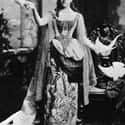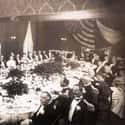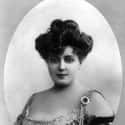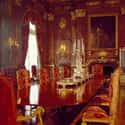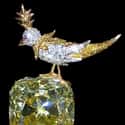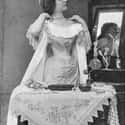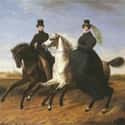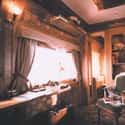-
(#1) Rich Women's Demand For Snowy Egret Feathers Caused Near Extinction For The Bird
The filthy rich of the Gilded Age just did not care. Not about anyone. Except themselves. Certainly they would not let the extinction of one of the world's most beautiful animals get in the way of their fashion sense and flair. During the late 19th century, fashionable women became enchanted with the luminous, wispy, gorgeous feathers of the snowy egret. Not just any feathers, mind you, but the ones that grew when the delicate birds were in breeding season, when they were preparing to give birth to their young. In many cases, egret hunters would kill and skin the mature birds right in front of their recently hatched young, leaving the babies to fend for themselves.
No matter. The women needed those feathers for their hats, dresses, and fans. Even for their home decor. The demand grew greater and greater until the snowy egret was endangered and nearing extinction status. To the credit of at least two society women, the species was saved at the last minute. An enormous campaign to protect the Snowy Egret and other birds killed for their feathers resulted in the Migratory Bird Act of 1913.
-
(#2) Lavish Costume Balls And Theme Parties Were The Standard
The rich of the Gilded Age literally had more money than they knew what to do with. So, they were always scouting about to find new and interesting ways to spend their wealth. Costume balls and theme parties were a special favorite, and they were most definitely a prime way to not only display wealth, but also to make a show of great spending on items that would be used for just one occasion and then tossed out or closeted away.
One of the most famous balls of the age was held on March 26, 1883. It was an extremely elaborate costume ball to mark the housewarming of Cornelius and Alva Vanderbilt's New York townhouse, which was built in the design of a French chateau. There was a bit of a problem, though. The Vanderbilts were "new money" and not established in New York society in any way, shape, or form. This was a humiliation, especially to Alva (pictured above in her ball costume). So, she planned the party of all parties and even invited the media in to tour the new house and view the fancy party decor. She pointedly did not send out an invitation to certain old money families. At this point, the Grande Dame of New York society, Mrs. Astor (who had a daughter who was dying for an invitation), was compelled to drop off her calling card at the Vanderbilt house, which signified that the Vanderbilts had at last arrived. Alva was delighted. So was Mrs. Astor's daughter. Not so much Mrs. Astor.
The party really was amazing. The costumes were custom made and imported from Europe, featuring figures real and mythological from throughout European history. The house was decorated in silver and gold finery, with colorful flowers abundant on every floor. One floor was transformed into a tropical garden, and rooms throughout were lit by Japanese lanterns. Thankfully, for historians and the curious, Alva hired professional photographers for the event, and many of the photos taken that night have survived to prove that such a ball really took place.
-
(#3) The Only Known Solid-Gold Toilet In The US Adorned A Robber Baron's Mansion
Yes, there are actual toilet seats of solid gold. And, certainly, the Robber Baron families were going to be among the owners of the same. The railroad tycoon family, the Garretts, bought the palatial Evergreen estate near Baltimore, Maryland, in 1878. They immediately set to remodeling and making the place even more grand than before. One upgrade involved building a theater – replete with stage, seating, and ticket window – for the matron of the house to perform for her guests in.
Probably the most ostentatious update – in a home full of ostentation, mind you – was a golden bathroom, which still exists today. The bathtub alone is covered in 23-carat gold leaf. And to date, it also makes claim to the only confirmed toilet seat of gold in the entire United States. Talk about a "Royal Wee."
-
(#4) Dinner Parties Involved Dogs In $15k Collars And Lakes Inside Restaurants
Throughout much of the 19th century, the go-to restaurant for showing off was definitely Delmonico's in New York City. Endless lavish parties and dinners were held on the premises, with courses going from late afternoon into the wee hours of the following morning. One of the grandest shows put on at Delmonico's involved the construction of an indoor, landscaped garden, complete with a $10,000 lake in the middle. Swans were brought to swim and glide through the lake as guests enjoyed their rich meal. At a different (but equally opulent) dinner party thrown by a Mrs. Stuyvesant Fish, the guest of honor was Mrs. Fish's dog, adorned in a $15,000 collar for the occasion.
-
(#5) Diamond Jim And Lillian Russell's Infamous, Gourmet Eating Contest
The Gilded Age was overflowing with over-the-top everything – including food consumption. Those folks had enormous appetites – and often the waistlines to prove it. But that wasn't such a big deal in those days. Prosperous men were expected to appear on the portly side as a symbol of their status, and wealthy women were encouraged to display bountiful figures. As for the innumerable people, including children, who were going hungry around the country everyday, it is doubtful that the Gilded Agers gave them the first thought. Two standout eaters from the Gilded Age include railroad tycoon "Diamond" Jim Brady and then-A-list actress Lillian Russell.
Brady's contemporary, restaurant owner George Rector, is said to have claimed that Brady was “the best 25 customers I ever had.” Brady would start early with an elaborate lunch each day, often including two lobsters, deviled crabs, clams, oysters, and even beef, though he seems to have been a big fan of seafood. Dinner might include much more than lunch. According to author H. Paul Jeffers, Brady's dinners typically consisted of
“a couple dozen oysters, six crabs, and bowls of green turtle soup. The main course was likely to be two whole ducks, six or seven lobsters, a sirloin steak, two servings of terrapin, and a variety of vegetables"
When it came to beverages, Brady was a teetotaler, abstaining from all alcohol and preferring to wash down his rich courses with a river of orange juice. His gal pal, Lillian Russell, was also a big eater. On at least one recorded occasion, the two decided to have a corn-cob eating competition.
-
(#6) 200,000 Square Feet Of Luxury At The Vanderbilt Place
Not all the great estates of the Gilded Age were in New York City or Newport, Rhode Island. Northern winter climates inspired the super rich to build homes in more southern climes for their winter abodes and festivities. Chief among these is the Biltmore Estate near Asheville, North Carolina, which was constructed by George Washington Vanderbilt II between 1889 and 1896. The estate is enormous, covering nearly 11 miles. The building project of the main house, which has nearly 200,000 square feet, was such an undertaking that an entire working village was constructed near the site to house the workers, manufacturers, and supplies. A three-mile railroad spur was even built just to transport building supplies to the construction site. More than 1,000 workers were hired to build the great house.
The Biltmore remains in the ownership of the Vanderbilt family, and it is the largest privately owned home in the United States. To help with the high cost of modern maintenance and expenses, the house and grounds are open to the public, for a price, and a number of ticketed events are held on the site throughout the year.
-
(#7) Marble House Designed To “Outstaff, Outdress, And Outparty” The Competition
Competition, oh my! While most Americans and Europeans struggled to make basic ends meet, the Gilded Age elite struggled with one another, competing over who had the biggest, the most, the best... of any and everything. Perhaps chief among these were their houses. Newport, Rhode Island, was prime real state for the 19th-century one-percenters, and some of the families worked hard to outdo their neighbors. For example, when Cornelius Vanderbilt constructed his famous home, The Breakers, it was an attempt to one-up his brother, William K. Vanderbilt's latest showplace, Marble House. The latter Vanderbilt designed and planned his Marble House to "outstaff, outdress, and outparty" his brother and other Gilded Age gents.
The competition was so fierce that home construction of the super rich was covered in the local newspapers on a daily basis. The Newport Mercury reported that Marble House had 500,000 cubic feet of imported marble, as well as paneled walls portraying gods from the Classical age. Some walls were even coated in 22-carat gold leaf, all of it painstakingly applied by hand.
If this all seems ridiculously extreme, it certainly was. But there was an ancient precedent that the Gilded Age families merely followed. One only has to take a look at surviving Roman villas, the Versailles palace in France, and the Catherine Palace in St. Petersburg, Russia. The powerful have always felt compelled to put on a display, just to make sure that other powerful people knew they could keep up with the rest.
-
(#8) Even The Prostitution Was Excessive
Not all Gilded Age activities were put on display and written about in the newspapers. Certainly not. What better way to express one's manly prowess than in the bedroom? Nineteenth-century wives may not have approved but, since women were still considered property of their men, there wasn't much they could say or do about it. More than that, prostitution was effectively legal at the time.
There were quite a few brothels to pick from in the large, northern cities, but the créme de la créme working gals were found in New York City's Tenderloin District. One street in particular was remarkable for quality and variety: 39th Street, west of Seventh Avenue. It was known familiarly as "Soubrette Row" (soubrette is the French term for a saucy, flirtatious girl). This region of the Tenderloin was located conveniently around the corner from the Metropolitan Opera House. Apparently, all sorts of indecencies were on offer at the fancier brothels, some practices considered so scandalous that the girls who engaged in them were shunned by their sisters practicing more traditional sexual activities. But, after all, it was the Gilded Age, and money talked. For the right price, a man could have his every fantasy fulfilled.
-
(#9) Tiaras Required: Jewels Of The Gilded Age
If Gilded Age wives were in a furor over their husband's nefarious activities in upscale brothels, they had their husband's money to comfort them. And, after all, no self-respecting Robber Baron would want his woman going about looking shabby.
To that end, Gilded Age ladies literally dripped in jewels and other finery. Famous jewelers of the period, including Marcus & Co. and Tiffany & Co., designed and provided a myriad of gleaming, glistening works of art using rare materials, ranging from ebony to diamonds, sapphires, pearls, emeralds, aquamarines, enamels, and – of course – much silver and gold.
With these precious metals and stones, what could not be fashioned? Tiaras, pendants, elaborate necklaces, watches, dresser sets, earrings and bracelets, and more. Plenty to keep a lonely wife warm at night!
-
(#10) Sheets Were Changed Twice A Day And Outfits At Least Thrice
Yet another form of excess among the very rich during the Gilded Age had to do with the showing off of as many elaborate outfits as possible, as well as the presence of as many servants – performing quite specific tasks – as possible. For example, a Gilded Age household required the family to change their clothing up to several times or more per day. Morning suits and dresses were essential until just before lunch. Then, something, perhaps lighter, for the afternoon; then, change again into something more formal for supper; then, yet again, for any evening social activities at home or beyond. Should one also have plans for hunting, hawking, or riding during the day, additional outfits would be required. After all, one must keep up appearances, no?
Sometimes family members or guests would need to nap or rest during different times of the day. To that end, bed sheets would need changing at least twice per day. The poor, overworked staff labored without electric washing machines and dryers.
-
(#11) Extreme Dining, Entirely On Horseback
Most Gilded Age meals were elaborate affairs and almost always held indoors. However, there were certain notable exceptions. Naturally, the more outlandish, elaborate, and expensive, the better. In some cases, the dining would take place on horseback. Imagine polishing off those endless, rich courses, all the while steadying your mount and juggling china, crystal, and silver! Some guests reported the experience as among the worst sort of tortures. On one occasion, millionaire C.K.G. Billing hosted a horseback dinner at a swanky New York restaurant. Even the horses were treated like millionaires, as they were provided with their own individual bags of oats. All of this came at an enormous cost. Billing's bill came to $50,000, an amount unimaginable to most people in the world. For Billing? He was just showing off!
-
(#12) Tricked Out, Private Railroad Cars Were Must-Haves
One of the main objectives of life during the Gilded Age, if one could afford it, was to see and be seen in the most luxurious ways possible. The arrival of the age of rail was no exception. By the 1870s, private railroad cars – some opulently decorated – were the most fashionable way to travel. No humble wooden coach seats would do. The very rich boarded their own entire rail cars, where the walls were lined in velvet, the upholstery plush, and the decor akin to a fancy parlor at home. Such private cars had bedrooms, running water, and a private water closet.
New Random Displays Display All By Ranking
About This Tool
"The Gilded Age" is a novel co-written by American writers Mark Twain and Charles Warner, which was published in 1873. This novel uses realism to boldly expose the decadent darkness of capitalist development after the American Civil War. Therefore, the period from the end of the Civil War to the beginning of the 20th century was named the "Gilded Age". This is an era of unrestrained individualism, which admiration of money and luxury life.
This era created many famous rich men such as Rockefeller, Fix and Gould, Hill, and Harriman, etc. The gap between the rich and the poor in the Gilded Age was so wide that the lives of the rich were beyond the imagination of ordinary people. The random tool reveals 12 unbelievable excesses of rich people at that time.
Our data comes from Ranker, If you want to participate in the ranking of items displayed on this page, please click here.












